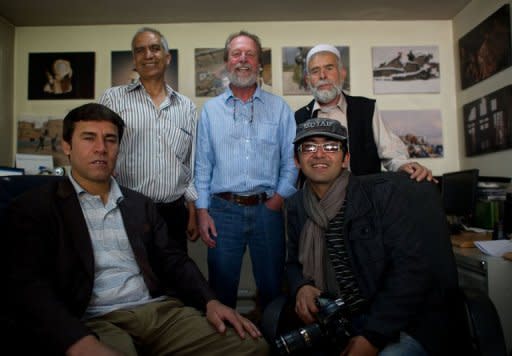Pulitzer Prize picture highlights ethics debate
It is a picture of pure horror that is difficult to look at. But Agence France-Presse photographer Massoud Hossaini's gut-wrenching image of an Afghan girl crying in fear after a suicide bomber's attack last December was widely disseminated and on Monday won the Pulitzer Prize for breaking news photography. Some newspapers used cropped versions of the picture at the time to remove the more disturbing images of blood and bodies, including one of a small child. But The New York Times and others published the photograph intact on the front page the day after the attack. Online news outlet MSNBC declined to run the picture at the time, saying "the dead bodies of children would be too disturbing to our readers," but published it Monday in a report on the Pulitzer with a warning of "graphic images which some viewers may find disturbing." Journalists have long debated the use of graphic and violent images which can offend readers and sometimes inflict more trauma on victims and their families, says Jane Kirtley, director of the Silha Center for the Study of Media Ethics and Law at the University of Minnesota. But Kirtley says images such as these tell an important story and should not be suppressed. "My own view is that it is absolutely ethical to take and publish photographs like this. It is part of telling the full story. It is not something the public should be shielded from," she told AFP. In the past, Kirtley said, many newspaper editors would avoid "a picture like this on the front page where people will be consuming it with their morning juice." But the Internet has changed those considerations because of the proliferation of bloggers and citizen journalists, since "anyone with a camera and access to the Internet can publish these images." Kirtley said editors can soften the impact of painful images by moving them from the front page to an inside page, or in the case of online news, to require users to click through a warning to see the image. AFP's Hossaini said that he, too, was traumatized by the events of that day. "The first and second night I had trouble sleeping. Whenever I was closing my eyes I was going to the scene, asking myself what else could I have done for those people, why didn't I help anybody?" he said. By winning the award, he said he felt he had given the victims of the Afghan war a voice. "I know that whoever sees this photo will think about the photographer but I hope they don't forget the pain Afghanistan's people have in their life," he commented. "This is kind of the good part for me, that I can right now reflect the pain of the Afghan people to the world, tell the world what's going on in Afghanistan." Susan Moeller, director of the International Center for Media and the Public Agenda at the University of Maryland and author of a book on war photography, said it is important for the media to explain the context of such images. "I think there needs to be some kind of conversation... about why an image is appropriate, whether it is an image of gore, whether it is an image of exploitation," she said. Moeller used the image in her class for a discussion on the appropriate selection of pictures, and found that students who had lived through violence in Asia or other areas or who had been in the military "were the most in favor of seeing the photo in its most explicit terms." Those who wanted the picture to be used were those "who had the most personal connection to the events or to the meaning of the photo," Moeller said, while many others who had no experience in war suggested that it might be too disturbing for readers. "This is all the more reason why such photos need to be understood as teaching moments," she said. "They are not just representative of the events they depict. That's their primary power." Moeller said the same debates have been taking place over many decades. "Everyone thinks things are so much worse and that the Internet has made coverage more aggressive... It has not, but it has made the images more accessible to more people," she said. "There have been graphic images since photography was invented in the 1840s."





